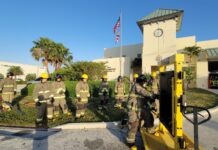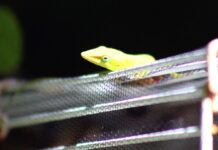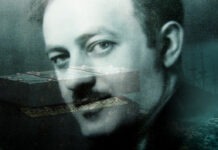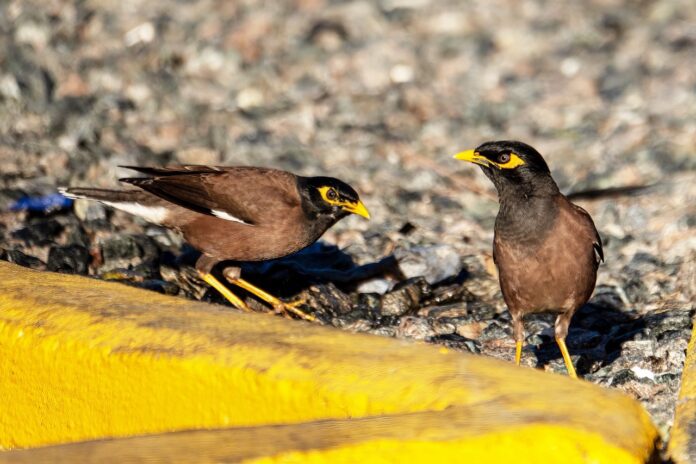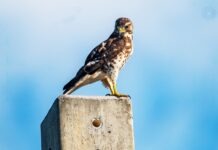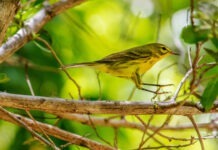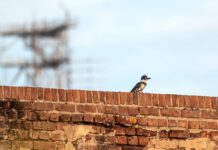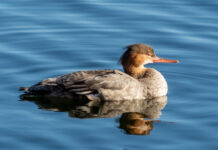It is hard to look at a common myna and not think that it is up to something.
Maybe it’s the black balaclava head. Maybe it’s the rubber duck yellow bill that connects to the rubber duck yellow patch of bare skin that curves below and around the back of the eye like a curling wave. It gives them the look of a charming scoundrel, of a gentleman bandit who’s maybe a little too flamboyant for his criminal ways.
Maybe it’s the slightly-less-than-rubber-duck yellow legs, or the white spots on their wings that flash like a low-wattage strobe when they fly. Maybe it’s the way they strut chest-first when they walk, as if they are about to go set someone straight.
Whatever it is, they are a hard bird not to notice, not to raise an eyebrow at. And I’ve been noticing them a lot lately, mostly in parking lots. In the past week I’ve seen them at both Key West Publixes (Publi? Publixi?) as well as gas stations in Marathon and Florida City.
It’s possible I’m bringing my own baggage to this, that I find it harder to ignore common mynas than most people. I’ve had something of a personal relationship with them for a pretty long time, though it is decidedly one-sided.
Most people who consider themselves birders have what they call a spark bird, a species that sent them down the road of avifauna-oriented biophilia and into a life of staring into bushes, hoping to see something interesting. A lot of birders want you to know how young they were when it kicked in, how they saw a Rufous-sided towhee from the baby stroller, or a red-tailed hawk sitting on top of the swing set at their elementary school playground.
I wasn’t like that. I was almost the opposite of interested in such things when I was young. I remember, in the early days of school, seeing one of those cardboard cutouts that said “R is for Robin” up above the chalkboard and classifying it as just one more thing the adults demanded I care about that I didn’t – even when I saw a robin out in the real world, pulling at a worm just like in the cutout.
I was almost the exact opposite of interested in wildlife, unless it was something that might kill you, like a shark or a bear or a giant crocodile. I always worry about what would have happened if someone had pressured me to become interested in birds.
I was in my late twenties when I got bird curious, a thing that crept further upon me in my early thirties. I wasn’t great at it, but I could look at a bird and get methodical – look at the overall shape, the color, patterns in the plumage, look at the legs, the bill, the range maps. I could generally figure out what I was looking for.
And then one day I was walking the dog down by what used to be called Toxic Triangle and I saw it – this bird with a balaclava-looking head, a rubber duck yellow bandit mask, white spots on the wings when it flew. It was hanging at a slight angle off the halyard of a sailboat. But when I went back home and flipped quickly through my Peterson’s field guide, I didn’t see any bird that looked remotely like the one I had seen. I went back to the beginning and leafed slowly through the field guide. Nothing.
I figured it had to be me, that I was jumbling the bird’s field marks in my brain, which is easy to do when you’re starting out. Competence takes time.
The next week I saw the bird in the same place. And two weeks after that. And repeatedly down there for months.
This was before the era of digital photography and I, like most birders at the time, did not have a camera. But I took diligent notes. And I would go back and work slowly through the Peterson’s. And I would come up with nothing.
Finally I tracked down a copy of the Golden field guide. Nothing. Same for the “All The Birds In North America” field guide, which organized birds not by taxonomy but by similarities in appearance.
This whole birdwatching thing is stupid, I thought, though stupid isn’t the actual word I used. Still, I couldn’t stop thinking about the bird with the rubber duck yellow bandit mask.
Finally someone told me I should talk to this guy Dr. Mark Whiteside. He knew everything about birds. So I called him and described what I was seeing.
“Well,” he said, “You should probably stop by the house.”
When I did, he brought me into his shelf of bird books and pulled out something called the “National Geographic Field Guide to Birds of North America, 4th Edition,” the “4th Edition” part being clutch.
Whiteside opened the page to (you guessed it) the common myna and finally, after driving myself crazy over this bird for months, I knew what it was.
Why hadn’t I found this bird in the other field guides? Because the species had not been seen in North America when they were written. The common myna was an exotic, a south Asian species that had escaped captivity and first been spotted in Homestead in the late 1980s.
I wasn’t dumb. At least not in this instance. I was cutting edge.
Putting a name to the bird you are looking at is one of the most fundamental parts of competent birding. Not being able to do so for months had been strangely dispiriting, but also galvanizing. From that point on I felt like a legitimate birder, like I might actually know what I was talking about on occasion.
I got more obsessive after that – though when I just tried to look up a synonym for obsessive, the word wackadoo was offered as an equivalent.
There was worry for a while that the common myna population might go the way the closely-related and similarly-exotic European starling population did, but that has not turned out to be the case. Their range has spread not just down to the Keys, but as far north as Jupiter and as far west as St. Petersburg, but they are generally found in small flocks, and almost always in grocery store or gas station parking lots, surviving in an ecological niche that no one is really competing for.
For several years they were pretty easy to find in Key West. (They’ve always been pretty common in Marathon and Homestead.) But then I went several years without seeing one here. And now their population seems to have buoyed somewhat.
Seeing them is always a good reminder for me that it occasionally takes time to figure things out, but that if you can be a little zen about what you don’t know, you might actually be able to figure it out.
I still think robins are boring as hell, though.





